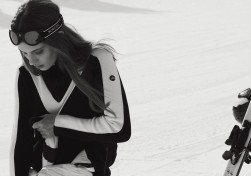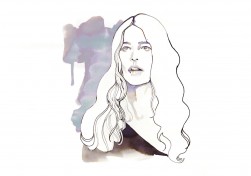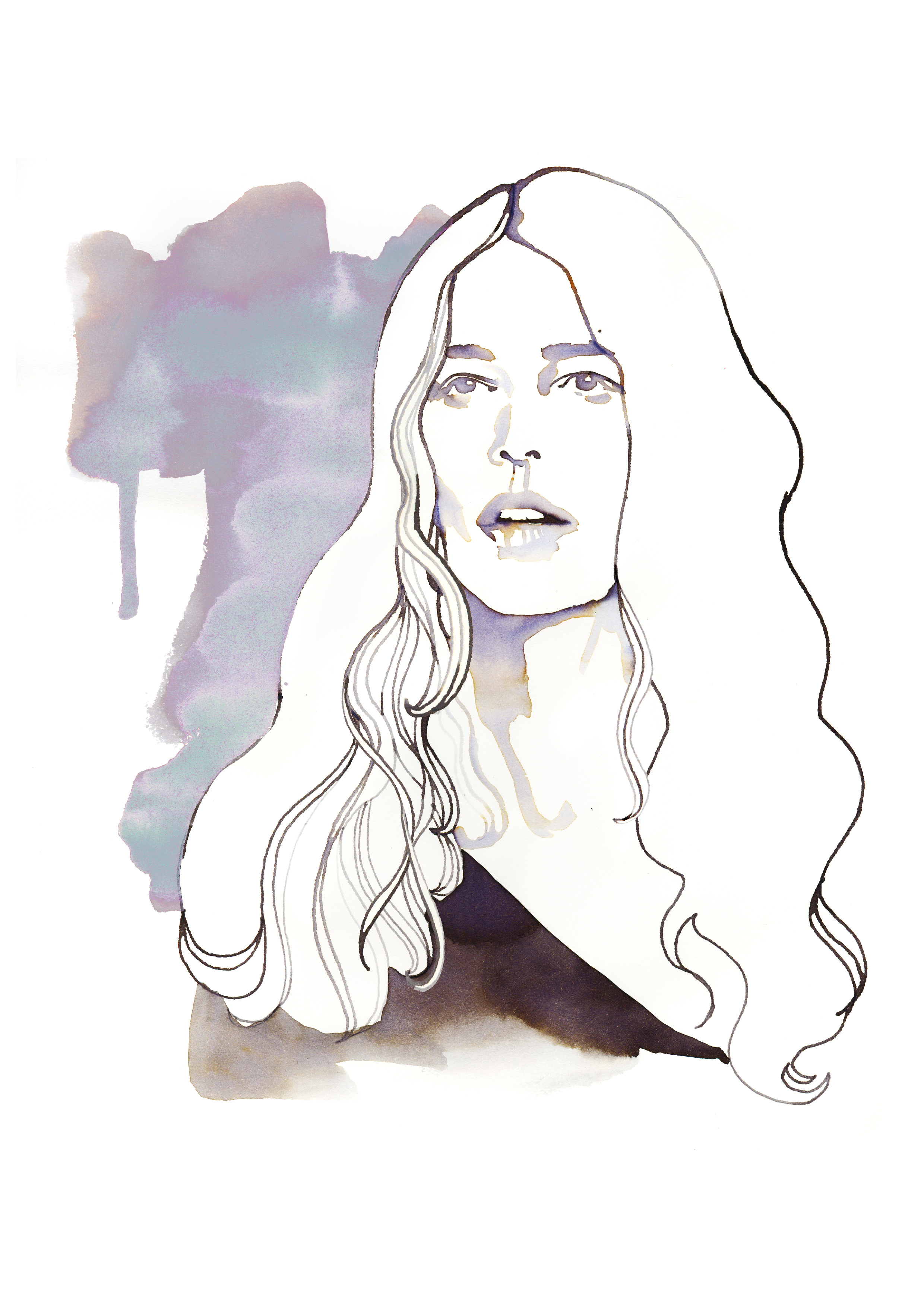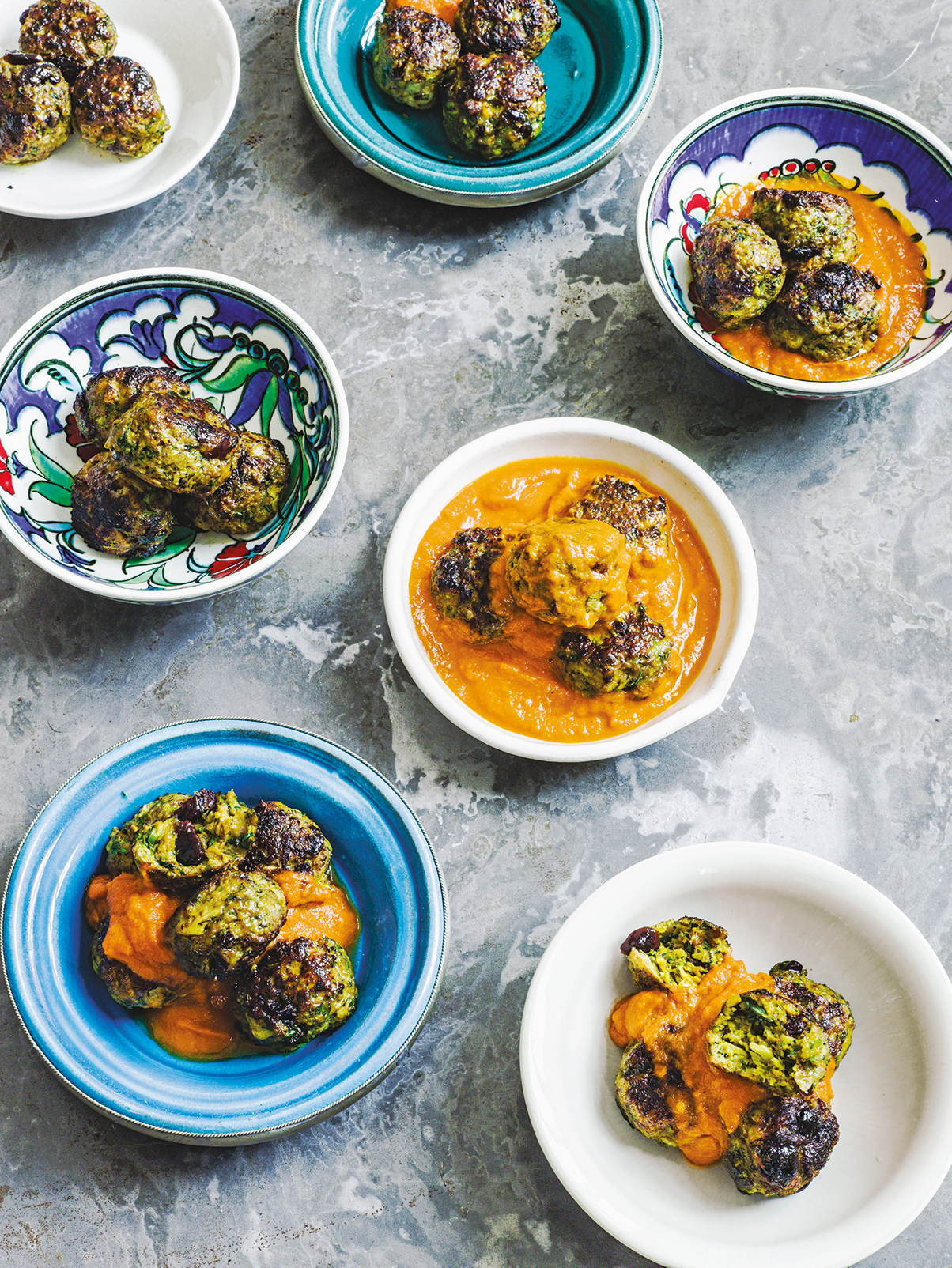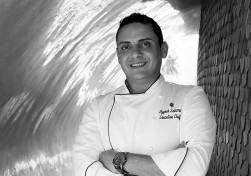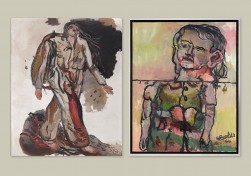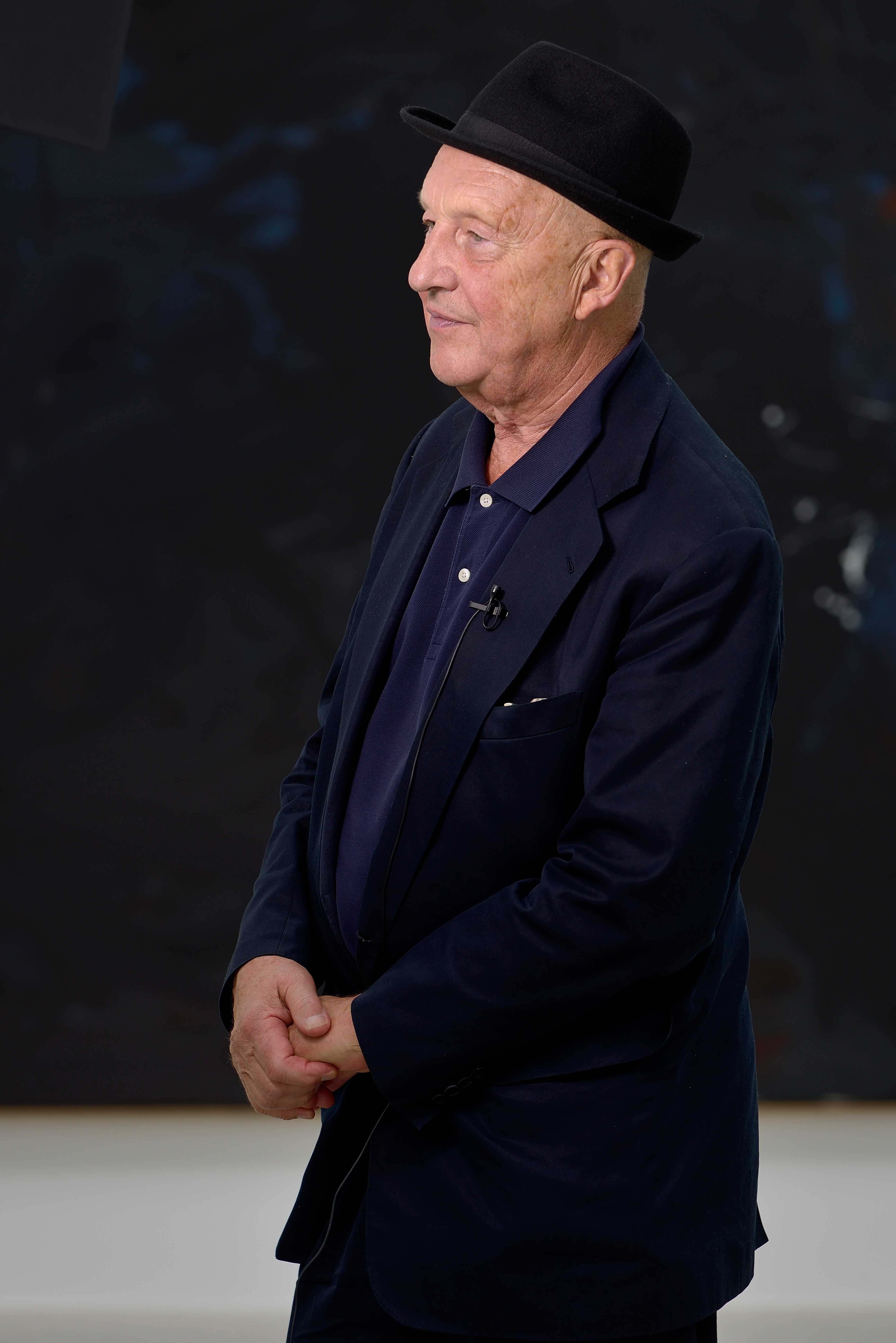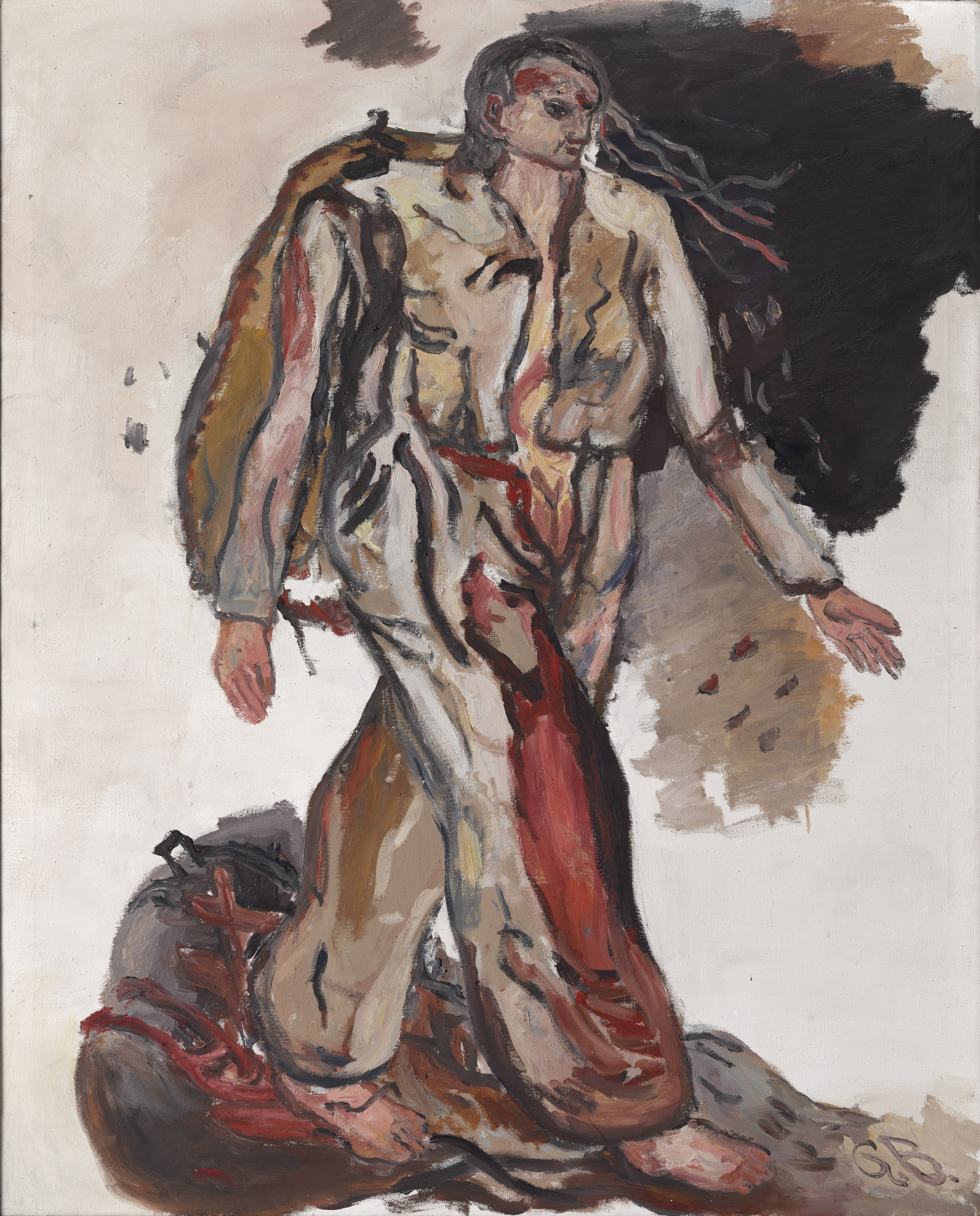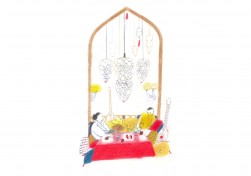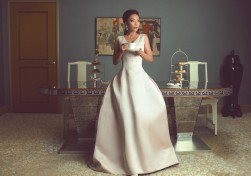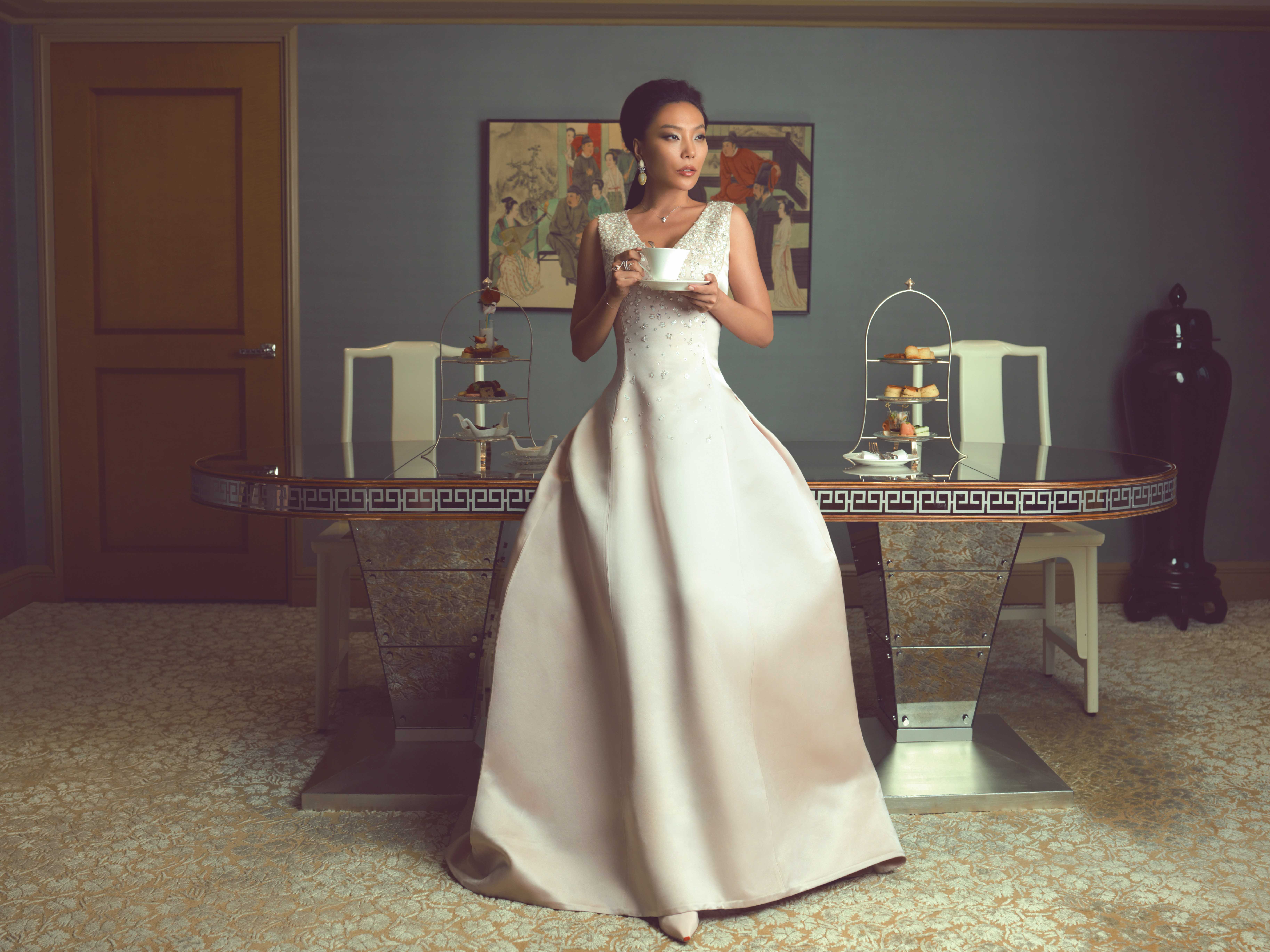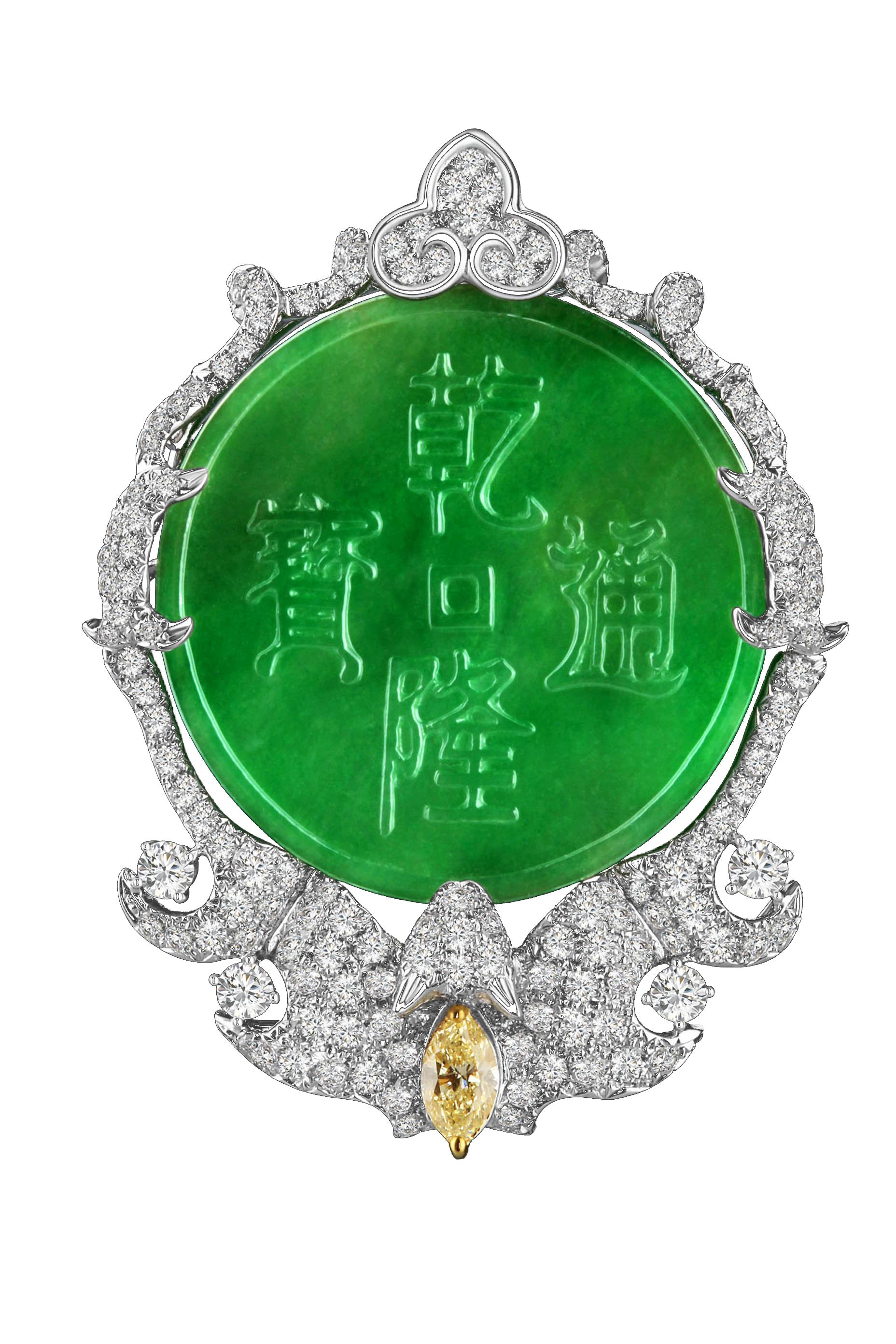1. Paris, 1987
One evening in 1987 I was at a nightclub in Düsseldorf when out of the blue I was asked by a complete stranger if I wanted to be a model. Of course I thought it was a joke and asked him if he meant my best friend, who to my mind was a far better candidate for the job. The stranger insisted he meant me, so I just assumed they were making a big mistake and they’d soon come to realize it. But before long I found myself in Paris. I didn’t speak a word of French at the time, so I opted for the tactic of pretending to understand, saying “Oui” a lot, and making the most of what I thought would be a very short-run thing, in a world I could never believe I’d ever be a part of. I have never been so happy to be so wrong. My career took off and I had suddenly found a place where I felt safe and was becoming the model I’d dreamed of being – although it only worked when I had a camera pointing at me. When I first heard the term “supermodel” I couldn’t help laughing because it felt so apt; there I was playing at being Superman while I was working, when in real life I was actually Clark Kent.
2. Rome, 1994
In the early 1990s, Valentino and photographer Arthur Elgort had the idea of doing a La Dolce Vita shoot for an advertising campaign, inspired by Anita Ekberg’s character in the Fellini film. It was one of those chaotic, crazy moments where life imitates art. There were crowds of people and paparazzi and TV crews following us non-stop as we shot in some of the city’s most iconic spots. Valentino has his atelier in the city center, and for one picture I had to stand on the balcony and wave. I looked down and there were thousands of people waving back at me.
3. Los Angeles, 2008
Shooting the Yves Saint Laurent campaign with photographers Inez and Vinoodh in the Hollywood Hills was another pinch-yourself moment. It’s rare to be able to get close to the iconic “Hollywood” sign, let alone pose against it. The shoot centered on the letter “Y” of the sign (Y for Yves). It was a beautiful day and the view over Los Angeles was remarkable. It changed the way I would see the city forever.
4. Garmisch-Partenkirchen 2015
This magical Bavarian resort is one of my favorite places for skiing. I discovered it when my husband [director Matthew Vaughn] went there to film Eddie the Eagle.
5. Amalfi Coast, 2017
I love the Amalfi Coast in Italy; we went there on our last family holiday. There are so many beautiful little towns as well as the larger ones like Positano and Sorrento. We went to Capri while we were there – it’s so beautiful and the atmosphere is so relaxed and fun, like an old movie.
6. Milan, 2017
When the call came through from Donatella Versace, I didn’t hesitate. It was a tribute for Gianni, and the perfect reason to do a final runway show. To keep the show secret, Donatella booked us all into separate hotels around Milan. Backstage, she arranged for each of us to have our own little make-up room, our own team, a Versace bathrobe with our name on it, and a handbag with our initials on. It was the sweetest welcome. Everyone backstage was half in tears before the show even started, remembering Gianni.
7. Berlin, 2017
I left Germany when I was 17, so every time I go back it feels like a homecoming. Last year I was honored to be awarded the Fashion Icon Award at the BAMBI Awards in Berlin. It was such a full-circle moment, especially because I had received the BAMBI Shooting Star Award when I was 21. When I was just a teenage girl, in Rheinberg, I would daydream about being a fashion model, a fashion designer, seeing my name on products, winning a BAMBI. And today, all of this has come true. I say this not to boast, but to say to all the young dreamers that I’m living proof that if you dare to dream, if you work hard, if you behave with integrity and never give up – amazing things can happen.
Claudia Schiffer, written by Claudia Schiffer is published by Rizzoli
The celebrated Egyptian food writer Claudia Roden remembers clearly the meals she had in post-war London, having fled Cairo during the Suez Crisis. “False cream, false meat, false everything,” she says with a shudder. “It was a shock.”
In a bid to comfort her daughter in their new home, Roden’s mother would cook familiar Egyptian dishes and invite fellow émigrés to share them. As the chef puts it: “We might have lost our homes, our possessions, our livelihoods, but we had the dfeena, the kibbeh, the kunafa: dishes that embodied the glories and warmth of Cairo, and all that we were homesick for.”
More than half a century after Roden collated these recipes into her international best-selling A Book of Middle Eastern Food, the cuisine that she championed has become celebrated among food lovers all over the globe. It’s thanks to her, supermarket bosses admit, that on our shelves today you are as likely to find hummus as you are ham, and baba ganoush as you are butter.
Roden might have told us about these flavors half a century ago, but it has taken a while for us to embrace them, she says. First, a few western shops, she says, started to stock basics such as couscous, bulgur, halloumi, chickpeas and filo pastry. “Then, in the Nineties, supermarkets started to use my recipes for things like baba ganoush. And now, at last, things like pomegranate molasses, tahini, harissa, za’atar and dukkah, which I’ve used all my life, are being championed as part of the new ‘modern’ cuisine.”
Thankfully for those who appreciate the exotic but earthy tastes of Middle Eastern food – a generic term that encompasses flavors from the souks of North Africa to the mountains of Iran – Roden’s once-solitary crusade has now been joined by chefs all over the globe, including Israeli-British, vegetable-loving Yotam Ottolenghi and Persian-inspired Sabrina Ghayour.
When Ottolenghi opened his first café in London’s Notting Hill in 2002, it was an experiment to see if the neighborhood would buy into his inventive repertoire of primarily vegetarian dishes. Sixteen years on, so great is his following that he has opened five more restaurants, writes food columns for The Guardian and The New York Times, and has sold hundreds of thousands of books that have changed the way families eat across the world.
In the US, meanwhile, market research firm Datassential reports that the appearance of falafel on restaurant menus has risen by 40 per cent in four years. New York City is particularly enamored with Middle Eastern cuisine, a passion further ignited by the arrival last year of celebrated Tel Aviv-based chef Meir Adoni. The menu at his acclaimed Flatiron restaurant, Nur, includes dishes from Morocco and Libya as well as Israel, Yemen and Syria.
So why the sudden popularity in the west of Persian, Moorish and Ottoman cuisines that have been enjoyed in their homelands for centuries? Not only have we been traveling more, says food writer Bee Wilson, and learning to love relaxed, meze-style sharing platters, but we are also exchanging recipes like never before.
In 2016, at the Diálogos de Cocina food symposium in San Sebastián, she reports, the hottest topic was not a new technique, or a star chef, but the explosion of recipes on social media. It is a revolution, she says, that has not only allowed anyone, anywhere, to watch cookery demonstrations, but for recipes to travel around the globe – from a traditional café in Amman to a hip food truck in Brooklyn or a St. Regis restaurant in the Maldives.
People’s obsession with their health may also have contributed to the cuisine’s rising popularity, says chef Sabrina Ghayour, whose 2014 cookbook Persiana sold 150,00 copies in the first year and has been printed in 12 countries worldwide. “Unlike European food, with its dairy, butter, cheese, meat and oil,” she points out, “Middle Eastern food is full of fresh herbs, nuts, fruit and seasonings that are known to be good for you. Even our pizza, or musakhan, has toasted almonds and citrusy sumac on it. And because there are so many delicious spices, you can turn even a basic carrot into something appealing, just by adding harissa and cumin.”
The simplicity of many dishes has also encouraged relatively inexperienced cooks to try new recipes, she adds. “You don’t have to be incredibly skillful to make slow-cooked lamb, and serve it with cumin salt,” she says. “And just a sprinkling of Persian spice, or a handful of aromatic herbs, can transform a boring dish into something quite exciting.”
The expansion of delis selling fresh ingredients has contributed to people’s familiarity with these once-exotic foods, too. Ottolenghi now sells online a “desert island hamper” of “essential ingredients”, from crushed freekeh and dried barberries to preserved lemons, so that chefs anywhere can join the growing tabbouleh-making throng. “These days cooks everywhere are as likely to need pomegranate molasses and date syrup to make dinner as they are olive oil and lemon,” he says.
If he’s right, our store cupboards will never be the same again. Salt and za’atar, anyone?
Middle Eastern cuisine can be sampled at St. Regis hotels throughout the world, from the newly opened The St. Regis Amman to the casual beach restaurant at The St. Regis Maldives Vommuli Resort
Image courtesy of Liz & Max Haarla Hamilton. Persiana is published by Mitchell Beazley (octopus books.co.uk)
Chef Ayyoub Salameh has a passion for creating contemporary, elegant new dishes, and has cooked everywhere from Milan and Florence to The St. Regis Maldives Vommuli Resort. Today, he oversees the island’s four restaurants, serving up delicious Mediterranean and Asian cuisine – as well as some of his Jordanian mother’s tried and tested secret recipes.
Who taught you to cook?
I definitely got my palate from my mother. She’s an incredible chef, who makes everything from scratch. Our basement in Jordan is full of homemade preserves. Every couple of months she’d bring out something different to surprise us. In the restaurant today I do the same, from pickling green beans and cauliflower to making chili sauce and fresh Japanese mayonnaise.
What food did you grow up on?
We’d start every day with a halloumi omelet, a plate of arugula and tomato, and some freshly baked saffron bread. Our parents would make my brothers and me have salty olives, too, to remind us to stay hydrated, and we’d have spicy extra-virgin olive oil, made from the olives in our garden.
Can you remember the first thing your mother taught you to cook?
Saffron rice. I didn’t want to learn how to make it because I thought it was so basic. But she told me that if you can cook incredible rice, then you’ll always be able to cook everything perfectly, because that’s the hardest thing to do.
Where’s home for you when you’re not in the Maldives?
Melbourne – there’s no foodie destination like it. As soon as my plane lands I’ll head straight to South Melbourne Market, and buy all my vegetables, fish, cheese. Then I’ll head to Gazi, a great Greek restaurant, or Corda, an amazing Thai place, both run by old friends.
What do you do when you’re not cooking?
I never miss the gym. I’ve lost over 42 lbs since May, but I don’t go for health reasons – I just like to start my day energized. If I don’t get there by 2.30pm then I feel like a zombie.
What’s your guilty pleasure food?
Steak. If I’m good, I’ll have 300g of lean, grass-fed rib-eye. If I’m feeling naughty, I’ll get a lovely piece of grain-fed Australian beef that’s a lot fattier.
How long does it take you to create new recipes?
It depends. I come up with something new each morning, often after chatting to guests at dinner the night before, but other dishes take much longer. It took us two-and-a-half months to develop the perfect pastrami. I have one rule: if it doesn’t satisfy me, then it’ll never go out to my customers.
Who is your greatest inspiration?
Sergio Mei, a wonderful Milanese chef. He was more than 70 years old when I worked with him, and I learned so much. The most important thing he taught me was how to train people. It’s not enough to be a great chef; you have to develop a team of equally good cooks in your kitchen, too.
What’s the strangest request you’ve ever had?
A guest once asked for a saffron and black truffle risotto, but without the rice, – so it was basically just a bowl of truffles. I did it, and he was very happy. In fact he asked for truffles for breakfast the next day, too.
What’s on your kitchen playlist?
Every morning in the kitchen we sing All The Way Up by Fat Joe and Remy Ma after our meeting. It makes the team happy, which makes me happy. Sometimes I even unleash my dancing talents.
Is there a culinary trend you detest?
I find it sad when people try to turn very simple dishes into haute cuisine, but end up sacrificing flavor. I had a tom yum soup recently where the essence was cubes of jelly, broth was poured over the top, there was some dry ice, and the chicken was powdered. It might seem “wow”, but the flavors were completely lost, and that’s what cooking is all about: flavor.
Your address: The St. Regis Maldives Vommuli Resort
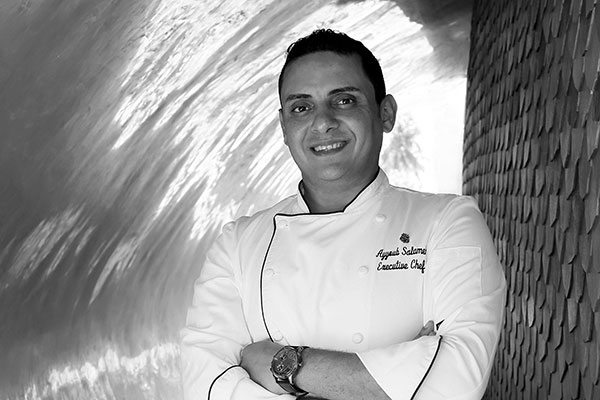
Ayyoub Salameh
Sleep, wrote Vladimir Nabokov in his 1967 autobiography, Speak, Memory, is a “nightly betrayal of reason, humanity, genius”. Only dullards do it, apparently. “Sleep is the most moronic fraternity in the world,” he declares. “It is a mental torture I find debasing.”
Nabokov’s romanticization of the writer as a hyper-alert insomniac forging his creative path while the world is sleeping couldn’t be more off-message today. It is, we now know, smart to sleep. Scientific research points to regular sleep as the gateway to brain function, wellbeing and an optimized immune system. In our 24/7, interconnected, performance-driven, global society, sociologists have identified a sleep and society agenda in which health, aging and life expectancy are key public health issues. We are living longer, and we want to live well. However, according to the World Health Organization (WHO), as many as 150 million of us worldwide suffer from some kind of sleep disorder; two thirds of us living in the developed world fail to get the eight hours per night WHO recommends. Neuroscientist Matthew Walker, author of Why We Sleep, has said that we are in the midst of a “catastrophic sleep-loss epidemic”. There are over 100 diagnosed sleep conditions, the most common of which is insomnia. Look no further than Shakespeare’s Macbeth to see the detrimental effects of sleep-deprivation. It’s a punishing condition.
Once upon a time, insomnia sufferers counted sheep to nod off. These days we might just as well recite the latest sleep trends that have sprung up. In our social media age, we use sleep monitors to tell us what is obvious: that we are no longer connected to our circadian rhythm, the internal clock that tells us when to rest and when to wake. Sleep, the most natural thing in the world, has been commodified, with a competitive sleep industry constantly inventing new ways to enhance, prolong and promote our sleep. It’s big business: the global sleep market is set to be worth $80bn by 2020.
Sleep science is a by-product of this industry, and its researchers point out that electronic media is now as much part of our going-to-bed routine as brushing our teeth. Sleep latency – the amount of time between getting into bed and falling asleep – must now be thought of as the gap between turning off an electronic device and falling asleep. As a recent study published in the Journal of Sleep Research earlier this year suggests, it might now be time to replace “lights out” with “media out”.
We would be wise to throw an ancient de-stressor into the mix, whether it’s acupuncture, meditation or a full body or head massage. The St. Regis Deer Valley Resort asks for 110 minutes of your time; that’s what it takes to send you on what it calls a Deep Sleep Journey. A full body treatment, it offers a level of relaxation that toxic time spent on Netflix or Facebook never can. A simple head massage, such as the St. Regis champi head massage, which uses Ayurvedic herbal oils, triggers points on the back of the skull that relieve tension and lessen insomnia. And yet many of us eschew such energy-releasers because we’re time-poor. Why? Because we aspire to do more and to achieve more. Hence the rise of the power nap, the sleep pod in the office and the very modern quest for quantified, quality sleep. Hence the rise of apps that track our sleep patterns and tot up our sleep debt.
One of the very latest offerings is a sleeping device called Somnuva – a sound management solution that looks like a standard Bluetooth speaker and digital clock. It uses sound therapies to break bad sleeping habits and restore natural sleeping patterns. Its USP is a sleep algorithm designed not only to get you sleeping better, but for the recommended full eight hours; it produces tones and pulses which are tuned to match the different stages and brain wavelengths of REM and non-REM sleep cycles. Once these sound combinations lull you to sleep, they supposedly keep you asleep. The brain subconsciously follows the sounds until your eight hours are up.
Even the common mattress has wised up to what media mogul Arianna Huffington dubbed “the sleep revolution”. One particular smart bed raises itself by seven per cent when the sleeper snores and, using air compressors in its frame, adapts to the sleeper’s body movements. Bed-in-a-box, vacuum-packed mattresses feature built-in sensors that sync with your smartphone sleep tracker app. Micro-climate mattresses are another trend; they adapt to your body’s change in temperature as you sleep, so that you are never too hot or too cold. Bamboo, gel or memory foam pillows do the same. Hot sleepers have kissed nights in white satin goodnight, choosing instead temperature-regulating, moisture-wicking sheets laid on top of water-based, app-controlled mattress-toppers. The so-called “performance” sheets use breathable fibers and harness the latest fabric technology. These, in turn, require performance sleepwear. Again, breathable fabric is key here, and nature once again looms large, with silken bamboo, already popular as a sportswear fabric, adapting to your body temperature.
Natural sleeping aids used as part of a winding-down ritual seduce us into a sleep-ready, stress-free frame of mind. Brief meditation or mindfulness sessions, a herbal tea, writing a mind-clearing To Do list or Gratitude list are as de rigueur as wearables and sleeping apps. Time-honored magnesium or – a favorite of The St. Regis Langkawi’s therapeutic bath ritual – lavender and coconut milk in a warm bath, provide the sweetest pillow talk.
Your Address: The St. Regis Langkawi; The St. Regis Deer Valley Resort
Despite being considered one of the greatest painters alive today, Georg Baselitz insists he has “never felt secure”. Now in his 80th year, and the subject of a major retrospective – his first in the United States since the mid-1990s – his journey to artistic preeminence has been far from assured. Controversy and antagonism have always gone hand-in-hand with his artistic genius. “I’m constantly scenting treachery and betrayal,” he says.
Baselitz’s father was a member of the Nazi party, and the artist grew up in East Germany within a Communist system that demanded total acquiescence to the state. This he rejected, as he did pretty much everything else. When his art-school teachers ordered him to paint in a strictly figurative social realist style, he refused – and was expelled for being “politically immature”.
Moving to West Germany did nothing to quell his belligerence. While the post-war art world was in awe of American abstract artists, Baselitz sought a third way, using both figuration and abstraction. The result was his 1963 painting, The Big Night Down the Drain, which depicted graphic and unsettling subject-matter in thick, fleshy paint using putrid, muddy colors. Unsurprisingly, it was confiscated by the police on the grounds of “infringing on public morality”.
But Baselitz was not simply out to shock. He wanted to shake Germany free from its amnesia about the recent past – so in his Heroes series he was even more explicit, depicting war-torn refugees and barefoot soldiers. The scale was epic but the paintings were grubby and bloody. “Why are my paintings ugly?” he comments. “Because I’m German.”
He gained further infamy when he began painting his pictures upside down, a literal interpretation of his need to upset the natural order. “What I admire about Baselitz’s later period work is his capacity to struggle against the ‘spirit of system’ that is a danger to most artists,” says Stéphane Aquin, chief curator at the Hirshhorn Museum in Washington, DC, who is organizing the artist’s retrospective. “He’s just been progressing with such ample strides and strength and power of conviction.” Baselitz’s public pronouncements have often matched his artwork in terms of stridency and impoliteness. “I was born into a destroyed order,” as Baselitz points out, “and I didn’t want to reestablish an order.”
Georg Baselitz, Bayeler Fondation, Basel, until April 28, and Hisshhorn Museum and Scultpure Garden, June 21 – Sept16, 2018
Your address: The St. Regis Washington, DC
Georg Baselitz
(Photo: Charles Duprat)
B.J.M.C. – Bonjour Monsieur Courbet, 1965. Oil on canvas
One of Baselitz’s Heroes series, this painting is a reaction against the clean lines and simple ideological messages of the art of social realism. Its style harks back to the prewar expressionist movement that had been suppressed by the Nazi government and labeled “degenerate”, but its title references the work of the 19th-century realist painter, Gustav Courbet. The result is an artwork that declares itself part of art history, and yet also wants to destroy it.
Geteilter Held (Divided Hero), 1966. Oil on canvas
For Baselitz, disharmony and destruction o en seem the only truths art can convey. A decapitated head sits on a mottled body while a large ear swells horribly. It’s a fractured painting for a fractured nation. Yet it’s also darkly humorous, a play on the distorted canvases of cubism, but here it’s less a single artist’s vision than an entire nation’s psyche that has been fractured.
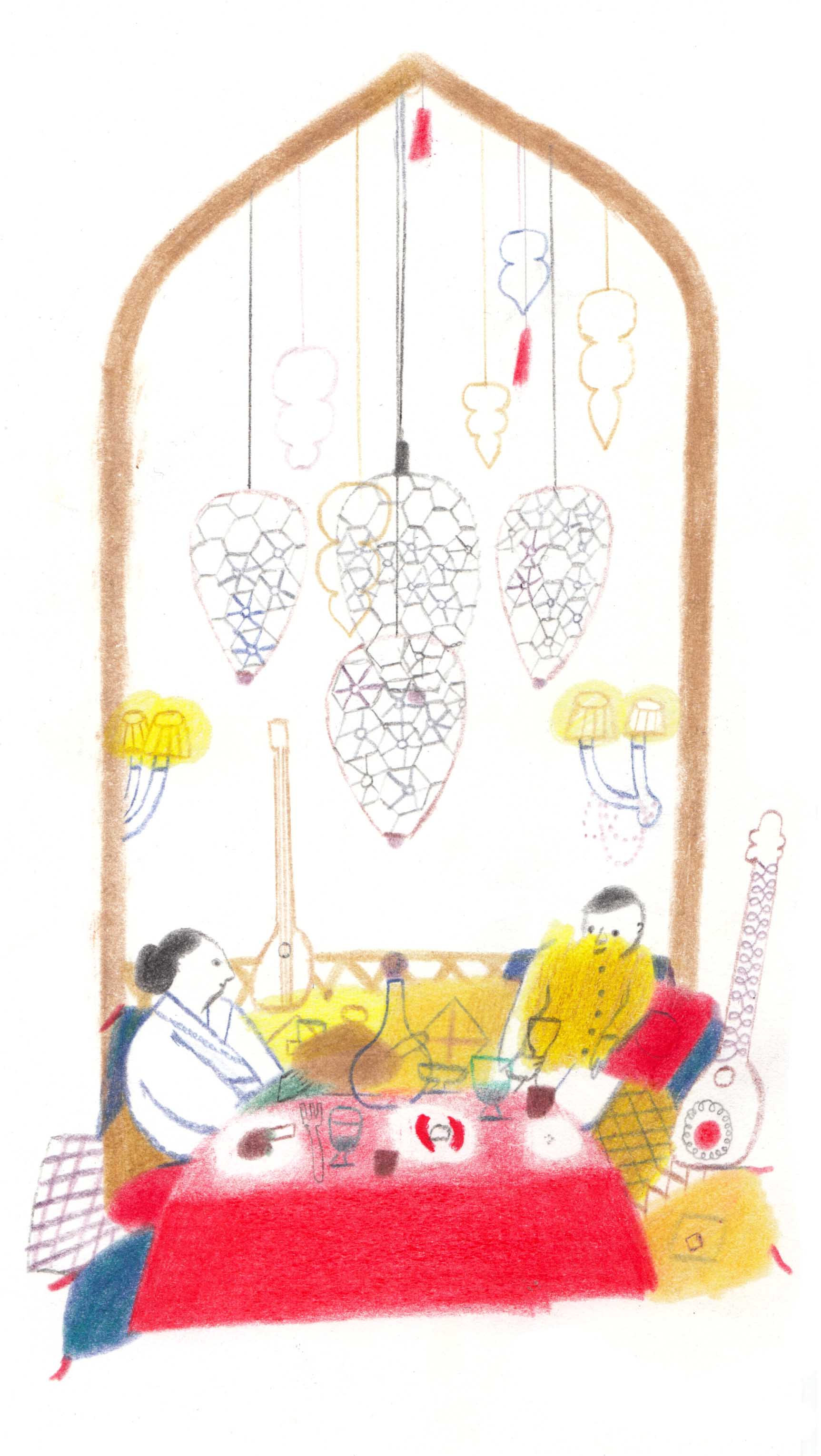
A traditional restaurant in Astana by Ryan Koopmans
Qazaq Gourmet, 29 Mangilik El St, Astana
This restaurant is in the main business area, near the Palace of Peace and Reconciliation (designed by Norman Foster) and lots of political buildings, so it’s right at the heart of Astana life. Although it’s on the ground floor of a modern luxury complex, inside they try to showcase the best of traditional Kazak food and culture. The staff wear local costumes as well as little hats inspired by those worn by nomadic Mongol swordsmen. There are musicians playing beautiful old instruments and dancers who swirl about in a central space. Although it sounds touristy, it’s not at all. It’s really well done, and feels upscale and interesting rather than cheesy. Visitors get so into it, they sometimes dress up in costumes too. The best thing about this place, though, is the food. It serves mainly meat, because that’s what Kazak people enjoy: lamb, then beef shashlik, and lots of horse meat, which is a staple here. The food is often accompanied by camel’s milk, which is an acquired taste. I prefer the vodka, which comes in little ceramic flasks. People have a really good time here. It’s somewhere you forget all preconceptions, and listen to people playing their traditional instruments and look at beautiful local souvenirs and iconographic paintings of mountains and horses, and just... have fun. It’s a real celebration of Kazak life.
Ryan Koopmans is an award-winning Amsterdam-based photographer (ryankoopmans.com)
Your address: The St. Regis Astana
A museum in Mexico City by Roland Herlory
Museo Experimental El Eco, Sullivan 43 Col. San Rafael, Mexico City
I love Mexico City for so many things. Not just for its energy, its chaos, its people’s sweetness, the colors, flavors, incredible food and the mountains. I love it for its architecture, from colonial buildings to art deco beauties and innovative midcentury structures. There’s one building I particularly cherish: the Museo Experimental El Eco. Located in the heart of Colonia San Rafael, El Eco feels more like a living sculpture than a museum. The building was designed in the 1950s by Mathias Goeritz, who was a sculptor before he became an architect – and it’s typical of its time: simple, pure, geometric, ambitious and humanist; a jewel in the middle of the urban jungle. In the past, it’s been used as a restaurant, a club, all sorts of things. Today, it’s a space for spatial experimentation, showcasing a range of different exhibitions. I’m always surprised by the emotion I feel when I walk in. It’s like a sculpture you can step into. Once you’ve experienced it, you can then wander to the city’s canals and take a boat to the city, or to Frida Kahlo’s house. I think it’s the best secret in town.
Roland Herlory is CEO of designer swimwear company Vilebrequin (vilebrequin.com)
Your address: The St. Regis Mexico City
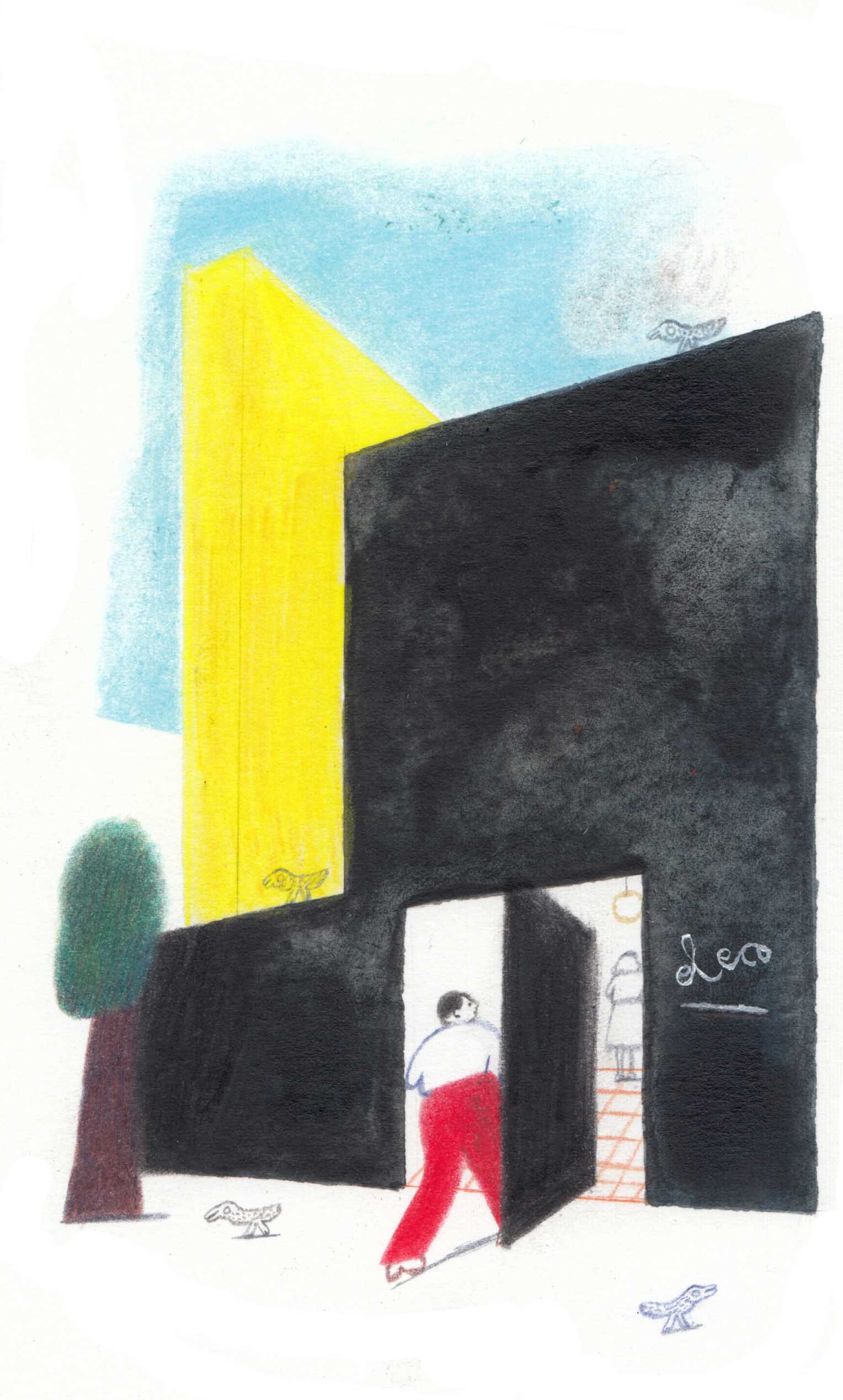
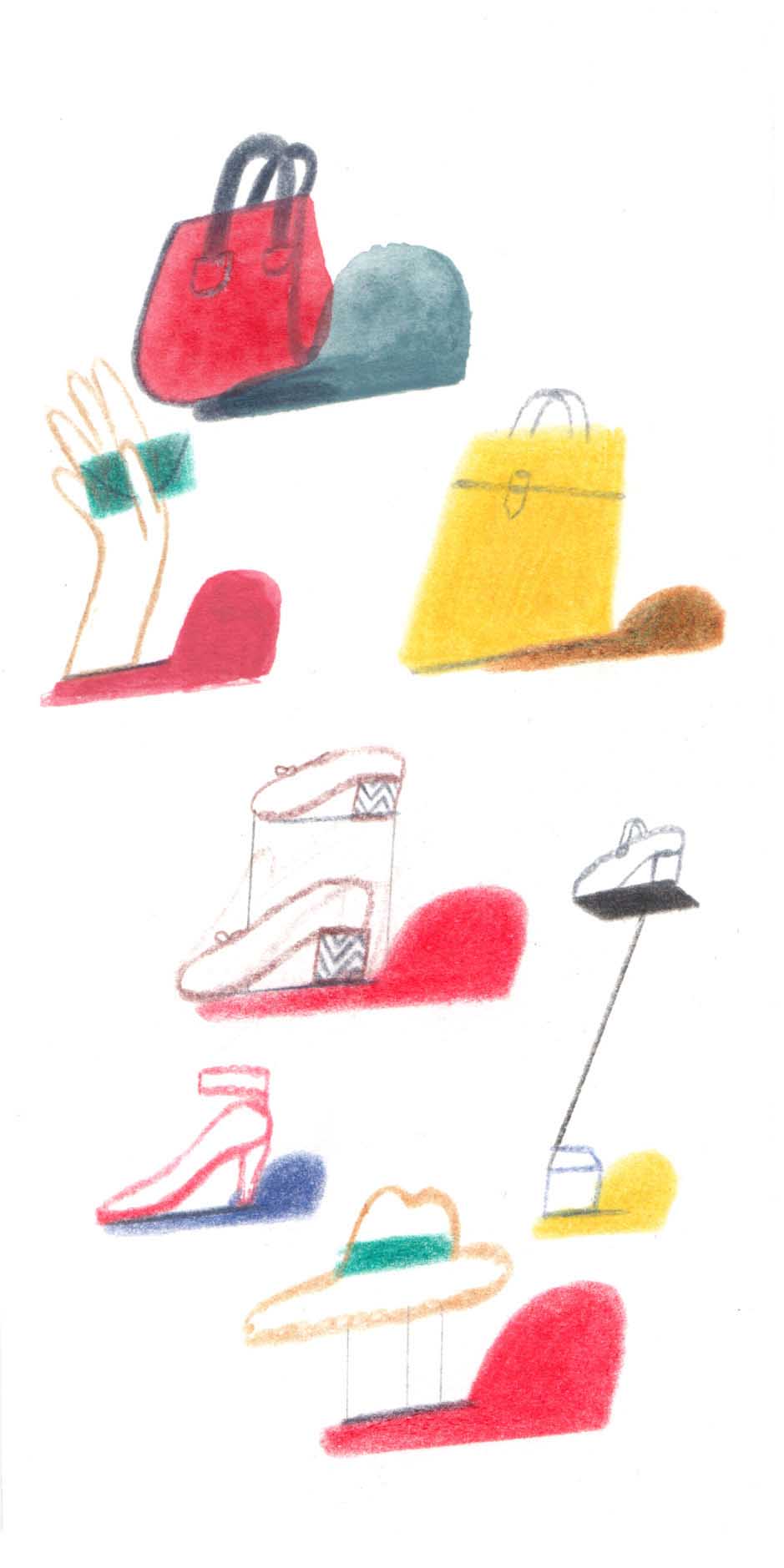
A luxury concept store in New York by Suzanne Syz
The Webster, 29 Greene Street, SoHo, New York
This concept store just opened in SoHo in New York, and it’s already one of my favorite places. The owner, Laure Hériard Dubreuil, who was a merchandiser for Nicolas Ghesquière at Balenciaga and Stefano Pilati at Yves Saint Laurent, opened her first store in Miami, then others in Bal Harbour and Houston. This one, though, is pretty unique because it’s in a six-story cast-iron house, in an area that was known for its artistic life. It feels cozy and homely, with light walls, pretty wallpaper and beautifully designed furniture, which you can buy. I like the boutique because you can get things here that you won’t find anywhere else: special-edition shoes by Gianvito Rossi and Louboutin, and pieces from labels like Prada and Miu Miu. Last time I went, I bought some of Dubreuil’s own-brand LHD pants and dresses – she does the best range of easy-to-wear clothes. It’s a place where you can wander from floor to floor and find new things: menswear on the third floor; jewelry; bags by Simon Miller or Loewe – pretty much everything a girl needs to be happy.
Suzanne Syz is the founder of her eponymous jewelry brand (suzannesyz.ch)
Your address: The St. Regis New York
A contemporary art space in Miami by Thaddaeus Ropac
Institute of Contemporary Art, 61 NE 41st Street, Miami
I’ve been going to Miami regularly for about ten years now for the Miami Beach Art Basel art fair – which is, after the original Art Basel in Switzerland, probably the most important art fair in the world, especially for the American market. And while fun is maybe the wrong word to describe something so intense, it’s a great event. What’s crucial about Miami Beach Art Basel is that everyone from the art world is there – the artists, the collectors, the other gallerists and curators. So if you’re working on a big upcoming exhibition, for example, Miami is a great opportunity to network. It’s a party town, of course – and there was a moment when we were afraid the parties would take over – but the quality is still there. This year I had a wonderful surprise, which was discovering the new Institute of Contemporary Art, Miami. It’s a great space for contemporary art right in the heart of the Design District, where there’s lots of activity, lots of shops, nightlife and restaurants and so on. These wonderful collectors, Irma and Norman Braman, decided to put their money and energy into the project. It’s not huge. It couldn’t rival the big museums in New York or London or Paris. But it doesn’t matter. It demonstrates the great role that contemporary art can play in a city like Miami – and it’s a wonderful place to visit.
Thaddaeus Ropac is one of the world’s leading gallerists, with galleries in Salzburg, Paris and London (ropac.net)
Your address: The St. Regis Bal Harbour Resort
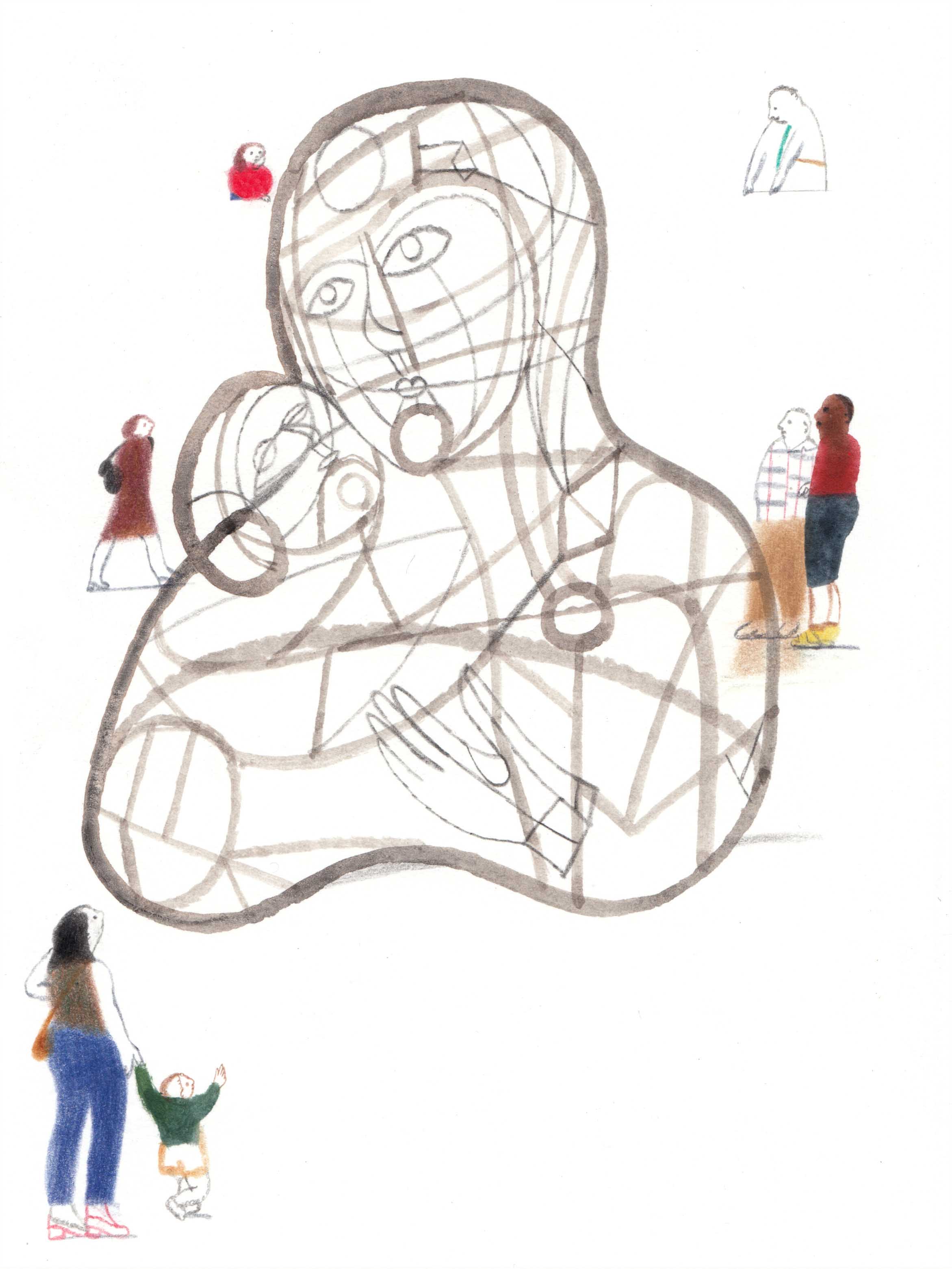
Bao Bao Wan is one of China’s most successful jewelers, with her own line of haute joaillerie as well as a more accessible range. Although she is successful in her own right, with collections stocked worldwide in stores such as Harrods in London and Lane Crawford in Hong Kong, the designer and socialite was born into power. Her grandfather was Wan Li, a vice-premier of China in the 1980s and a high-ranking member of the National People’s Congress, and she grew up within the confines of Zhongnanhai, the government compound in the former Imperial Gardens. Today, when Bao Bao (which, very aptly for a jeweler, means “treasure”) isn’t jetting between fashion shows in Paris, where she often takes her front-row place beside fashion giants like Bernard Arnault, and events such as the Met Gala in New York, she lives between Hong Kong, where her business is based, and Beijing. In 2016 she became the first St. Regis Connoisseur in China.
Given that you come from a political family, how did you become a jeweler?
My family were very supportive of whatever I wanted to do, which as a young woman was art and photography. Having studied French literature in Paris, then photography in New York, I went on to study gemology [at the Hong Kong branch of the Gemological Institute of America]. My studies rounded off my education, as I understand historical references as well as aesthetic ones when I’m making jewelry – and my Chinese background gives it soul.
Is there some jewelry that you never take off?
When I was younger, I used to wear small diamond earrings that my mother gave me. I left China at the age of 16 to go to New York and didn’t know anyone, and didn’t speak the language, so it was very difficult and very lonely. Wearing my mother’s earrings reminded me that I belonged somewhere. I stopped wearing them about a year ago, although they are still very precious – as is my mother. She is also creative, and is a great painter and calligrapher, and keeps me grounded. She comes from a very humble family, and reminds me of who I am, who my family are, and my roots, which are very important.
You’ve designed cufflinks for Dior, a car for Mercedes, a make-up line for MAC. Do you regard yourself as a designer or a jeweler?A jeweler, for sure. I love doing collaborations because it’s creative. So I didn’t just choose the color for the lipsticks, but the names. One MAC lipstick, which is a violet color, I called Lavender Jade; another I named Burmese Kiss. Doing projects like that is fun.
How would you describe your own style?
It depends what I’m doing and where I am. If I go to New York now it’s for some red-carpet event, like the Met Gala, so I’ll pack something fabulous. If I’m in London, I’ll go a bit more “elegant lady” and intellectual-looking. In China, with friends and family, I’ll be casual and sporty. In Hong Kong, it’s usually for business, so I’ll have a professional look. And when I go to Australia or Sydney it will be for a holiday, so I’ll take flip flops and shorts.
You once said that, as a girl, you thought of being a bus conductor “because they had extremely beautiful bags”! Do you remember your first handbag?
Yes, it was a Lady Dior, which I still use. I always go for classic bags, rather than the latest fashions. It’s the same with fashion: I still have some old dresses by [Maison] Margiela that I bought when I was studying in Paris. I’ll still take them out to admire them, even if I don’t wear them that often. A lot of great designs today are copies of yesterday’s, which is why I don’t follow trends. You realize after a while that you’ve seen it all before.
Any labels you love more than others?
Clothes made by the Chinese designer, and my friend, Huishan Zhang. He made the last dress I wore to the Met Gala: it was covered in 10,000 Swarovski crystals, and sequins and pearls.
Specific destinations in Beijing that you would recommend?
For fashion, a boutique called Joy, which has a mixture of western designers and local labels. For food, Temple Restaurant [TRB Hutong], which is in an old temple that’s hundreds of years old. And for a drink, the bar at The Georg [the restaurant at the showroom of Danish silversmith Georg Jensen], which is in a house in an old area of Beijing that has a beautiful courtyard, with a pretty fishpond planted with lotus flowers. It’s very soothing.
Do you have a strict beauty regime?
I do a lot of walking and biking and stretching, as well as Pilates, to keep in shape. When it comes to nutrition, I don’t eat many carbs. I like Asian food, which doesn’t have much dairy in it, or potatoes or cheese, so it’s light and healthy. In Beijing, I go jogging and biking quite a lot around the lakes in the royal parks. I don’t know what it is about water – it calms me down and is therapeutic.
You’re often featured on the covers of magazines. Do young women in China still read magazines? Or is technology changing that?
I won’t ever stop reading magazines, and I hope other people don’t either. I really love the feel of print. And I don’t want to have to look at a screen all the time.
Do you travel yourself to find stones for your jewelry?
Always. Stones are my real love. The problem with being a woman jeweler is that you fall in love with the stones and the pieces you make and get emotionally attached to them. I have quite a big collection of stones I can’t bear to let go. I’m very picky about what I buy – about the colors, the shapes, the brilliance – and if something is perfect, it’s pretty hard to sell. I love sapphires, emeralds, rubies, diamonds, but particularly alexandrite. It’s a stone that sometimes looks yellow, and sometimes white, depending on the light. It reflects different rays in different ways, which is so beautiful.
You’ve said: “I don’t want to put on jewelry so people just look at that – it has to be part of my life”. Could you explain what kind of jewelry you like now?
There are two types: red-carpet pieces, and effortless pieces that you can wear in the shower, to sleep in, when you’re jogging. A lot of actresses wear my jewelry whether they’re on the red carpet or working out. Our famous Chinese tennis player, Li Na [who won both the French Open and the Australian Open] was wearing my Gardens of Victory necklace when she won her biggest tournament.
Do you still get a thrill from fashion shows?
I prefer going to gemstone shows in places like Hong Kong and Basel and Thailand and Paris, and traveling to different countries to buy stones: Sri Lanka for sapphires or Burma for rubies. Some places are safer than others.
Do you like watches?
I’m not really into the mechanics of them. I wear a watch like I wear jewelry: for aesthetic reasons. All the ones I own are extravagant: for instance, one from Bulgari called the Serpenti 7 Coils, which looks like a long snake, and another from Chopard that’s set with emeralds. That’s unique: it’s the only one in the world, so it’s pretty precious.
Do you ever use a personal shopper or stylists?
No. I know exactly what I want, so I don’t need help. Although I don’t like shopping, so a personal shopper might save me time, so I could put more of myself into my work and my passions.
Many of the international brands today now have their bags and shoes and clothes made in China. Do you think the label “Made in China” no longer has connotations of being cheap?
For sure. If you look at labels like Huishan Zhang; his clothes are sold around the world alongside greats like Alaïa. My jewelry is sold at Harrods alongside Dior. So it’s changing quickly.
Tell me about the piece of jewelry you made for St. Regis.
The pin that I designed for butlers to wear on their lapel was inspired by the St. Regis hotel in New York. To me, it’s a very special place, not only because it’s unique and filled with American history but because it’s glamorous – even the cashier’s desk is beautiful. The swirl of gold on the edges of the pins reminded me of the gold you see on the elaborate door handles and on the arms of the chandeliers in the hotel; and the pearly white interior reminds me of the softness of the carpets and towels, which I love whenever I stay there.
Your address: The St. Regis Beijing

